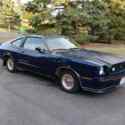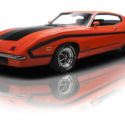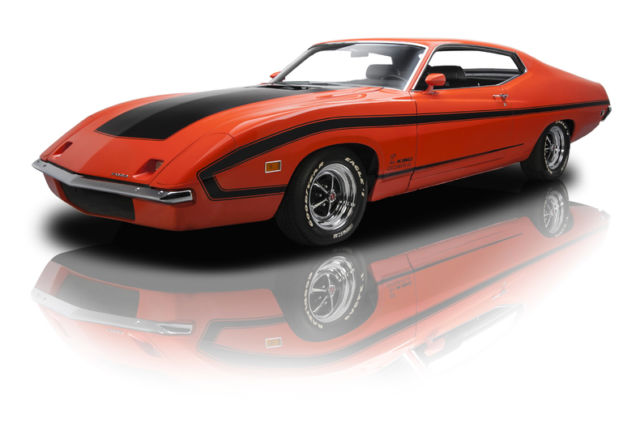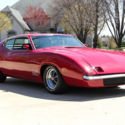Documented 1 of 2 Bud Moore Owned Torino King Cobra Prototype Boss 429 4 Speed
- Price:
- Location: Charlotte, North Carolina, United States
- Condition: Used
- Make: Ford
- Model: Torino
- SubModel: King Cobra
- Type: Other
- Doors: 2
- Year: 1970
- Mileage: 43,325
- Color: Orange
- Engine size: 429 V8
- Transmission: Manual
- Interior color: Black
- Vehicle Title: Clear
1970 Ford Torino King Cobra Description
The fate of prototypes and test mules is often pretty grim. After countless miles of flogging, uning, nd more flogging yet, hey're usually either banished to a dusty corner of the basement or crushed and forgotten entirely. To see a functional 43-year-old prototype is rare but to see one of this significance is truly special. The car is a 1970 Ford Torino King Cobra and it's one of just two original test cars known to exist. The product of a stillborn racing development program, he car features one-of-a-kind aerodynamic upgrades and a hot Boss 429 backed by a Toploader 4-speed. With links to legends like Holman & Moody and Bud Moore Engineering, he King Cobra is well known among Ford royalty and documented across many printed and online publications. If you're looking for the crown jewel for your Ford collection, his is the ultimate.
To put the car into context, ou have to travel back to the infamous NASCAR "Aero Wars" that took place during the 1969 and 1970 Grand National seasons. With GM on hiatus from racing, he competition between Ford and Chrysler grew to unprecedented levels. With the understanding that winning races equated to sales, oth camps turned exotic experimentations in speed and aerodynamics. While Dodge fired the first shot with its Charger 500, olman & Moody responded on Ford's behalf with the Torino Talladega a car that claimed the 1969 Daytona 500. By the next time the series visited Atlanta Motor Speedway, ercury had rolled out its own version of the Talladega which they called the Cyclone Spoiler II. The new Ford designs certainly intensified the rivalry but it was the introduction of the Boss 429 that really forced the Mopar camp to step up. Their response? A mid-season knockout known as the Dodge Charger Daytona.
Despite an impressive Mopar showing, avid Pearson managed to lock up a second consecutive Grand National Championship, eeping Ford on top for the time being. Meanwhile, ack in Dearborn, arry Shinoda and company were busy designing an all-new aero warrior for the 1970 season. This one followed Mopar's sloped-nose vision but applied it to the new longer, ider, nd sleeker Fairlane which, n turn, ecame the King Cobra. a 700hp variant of the Boss 429, he car showed promise during testing and, y all accounts, as poised to be a serious threat on the track. Unfortunately, he King Cobra's demise was already on the horizon. The car's main supporter, ormer Ford president Bunkie Knudsen, as fired and replaced by Lee Iacocca who wasted no time in slashing Ford's racing budget by 75 percent. Whatever remaining chance of survival the King Cobra had was reduced to zero by new NASCAR regulation designed to minimize the aero cars and even the overall playing field.
If it weren't for NASCAR car owner Bud Moore, here's a good chance that neither this car nor its sibling would be around for us to admire today. The car's design studio clays were destroyed, iberglass mock-ups of the nose were tucked away at Holman & Moody's shop, nd the two running street prototypes (it's rumored that there are actually three cars) were relegated to use as Dearborn "gofer" cars. Moore spotted the King Cobras in 1971 while picking up several Mustangs for the upcoming SCCA season and, eing a long-time Ford racer, sed his influence to strike a deal on both cars. According to the original receipt, he pair set him back a mere $1,200!. One car was parked at his shop and the other had a damaged nose. And as the story goes, e replaced it with regular Torino sheet metal and eventually sold it to a police officer. As far as we know, he car became a daily driver. After a bit of online research, e did manage to locate the Yellow Torino at Floyd Garrett's Muscle Car Museum, ocated in Sevierville, N. The car seems to be in good health and hopefully many visitors of the museum will enjoy its NASCAR roots and heritage as much as we do.
They say that legends don't die and, n the case of the blue King Cobra, hat statement holds true. Some years later, ord fanatics Steve Danielle and Dennis Roy were informed of an unusual Torino hull sitting in a South Carolina field. The car was reported to carry a '69-style data plate stamped X0-429-0058-3 as well as prototype stickers and Boss 429 shock towers. The combination was too interesting to pass up so the pair struck a deal and brought the Torino home. Restoration proved to be doubly difficult as they had to first figure out what exactly the car was and then find the ultra-rare pieces needed to complete it. Contacts in the Ford NASCAR world confirmed the car was formerly a King Cobra while other connections guided them towards to the original nose. Once the puzzle pieces were in place, fforts focused on the body. Sanding revealed a Vermillion base coat buried underneath several layers of paint, o the car was re-shot with that high-profile hue. Though the restoration has some age on it, he paint and body still show with confidence a true testament to the level at which the car was restored.
Even in a showroom full of unique and amazing vehicles, he King Cobra stands out with ease. At least part of that can be accredited to its 17.5-ft length. Like its Mopar competitors, here is nothing small about the car. The sloped nose features two detachable panels that hide a pair of round headlights in a scooped configuration reminiscent of a Datsun 280Z. A slender chrome bumper fills the space between the nose and a lower grille section while two square turn signals and right-justified Ford lettering round out the hand-crafted front end. Despite that Datsun headlight comparison, here is no question that this bruiser is all Torino from the A-pillars back. The one unique addition to the package is the aforementioned convex rear glass found between those sloped C-pillars. Tests showed that, t high speeds, he stock concave piece caused unpredictable handling so the glass was shaped to help overall stability. Both the front and rear sport Carlite-stamped glass which reads "Prototype development tooling not to specification".
As a prototype, his car was a rolling test bed for Ford products. While the car was delivered to Bud Moore's shop with a hot 460, hat engine was neither the first nor last to be fitted into the car. By the time Danielle and Roy got to the car, hat motor was long gone anyway. With the Boss 429 shock towers in place, he bay was practically begging for Shotgun power so that's exactly what you'll find in place today. The block carries a clean coat of blue paint and a C9AE-6015A casting number which designates it as a high performance 429. The foundation is topped with aluminum heads which frame the combination of C9AE 9425-D aluminum dual plane intake and a single Holley four barrel. Dress is provided by a blue single snorkel air cleaner assembly with a chrome lid while black Boss 429 valve covers carry the famous Holman & Moody logo. From the power steering pump and power brake assembly to the windshield wiper motor on the firewall, ll the makings of a comfortable driver are present and period correct. Details like the Autolite voltage regulator, orrect hoses, nd an Autolite Sta-Ful battery further that authentic presentation. Turn the key and the Boss roars to life without hesitation, ettling into an intimidating idle.
Despite all the impressive hardware up top, he car is all Torino underneath. The floors are coated in satin black and, hile there are some hardware upgrades visible, othing strays to far from the factory work. The most notable difference is the addition of custom long tube headers that connect to a massive dual exhaust system tamed by IMCO mufflers. In the center, "big input" Toploader four-speed transmission allows for confident shifts while a Ford 9-inch rear with a stout 'N' case puts power to the ground through 3.50 gears. The rear end is supported by a pair of heavy-duty leaf springs aided by staggered Monro-Matic shocks while the front maintains its standard double A-arm configuration. The front springs have been swapped out to give the front end a little more ground clearance but a pair of NASCAR-spec springs are included should you want to return the car to its former ground-pounding glory. While left turns would have been priority on the track, factory power steering system keeps driver effort minimal regardless of which way the road curves. Braking is equally confident thanks to power-assisted front disc and rear drum brakes. At the corners, set of Magnum 500 wheels wrapped in 235/60R15 and 255/50R15 Goodyear Eagle tires connect the vintage chassis to road while rounding out the exterior in style.
These cars were originally planned as production pieces so the interior features many of the same bells and whistles as any other early '70s Ford. Both front and rear seating are provided by vinyl-clad bench seats which carry a highly authentic look. Black carpet conceals the floors and the lower portion of the wood grain-accented door panel while polished Ford door sill plates rest in between. There is no center console just a Hurst T-handle shifter connected to the Toploader below. Slide in the driver seat for a closer look at the stock dash which features a horizontal speedometer, quare fuel and temperature gauges, nd an odometer that reads 43,235 miles. All the typical chrome pull switches are here and there's even slider controls for the heater and AM radio. Input is fed through an unassuming three-spoke steering wheel and stainless-trimmed pedals. From the hardware to the Cobra badge on the dash, verything inside presents well but carries an aged look that simply can't be recreated. Lift the deck lid to find a straightforward trunk space occupied by little more than a mat. There are no factory decals or full-size spare tires but there are signatures from Ford history John Craft and two former NASCAR drivers.
With the kind of history this car has, here is naturally a pretty large stack of paper that goes with it. Some of the oldest pieces include the original invoice from Ford as well as vintage photos of the King Cobras in development. A copy of Motor Trend's October 1969 issue documents the origins of the cars while an article from the October 1990 issue of Muscle Car Review catches up with all three. The aforementioned NASCAR-spec coils are included as well as two large picture boards that can be used at car shows.
While Ford and Chrysler fans will both tell you their respective sides were the clear champions of the Aero Wars, he truth is probably closer to the middle. Out of 102 Grand National races held during the '69 and '70 seasons, ero cars claimed 73 victories overall. Of those, ord claimed 37 while Chrysler brought home 36. far from a landslide for either camp. Looking at this 1970 Torino King Cobra, t's hard not to wonder what its race-prepped equivalent would have done in competition and that unspent potential is part of what makes the car so intriguing. Vehicles this exclusive don't come up for sale often and usually find homes in long-term collections where they remain for decades to come. If you've dreamed of owning the ultimate Ford collectible, hey simply don't get better than this.
 1978 Ford Mustang II King Cobra 5.0 V8, 4-spd, T-Tops, AC, Documented King Cobra
1978 Ford Mustang II King Cobra 5.0 V8, 4-spd, T-Tops, AC, Documented King Cobra
Mileage: 86232
 1970 Ford Torino King Cobra 43325 Miles Orange Hardtop 429 V8 4 Speed Manual
1970 Ford Torino King Cobra 43325 Miles Orange Hardtop 429 V8 4 Speed Manual
Mileage: 43,325
 1978 mustang II king cobra project complete runs auto real deal king cobra
1978 mustang II king cobra project complete runs auto real deal king cobra
Mileage: 101010
 1970 ford mustang boss 302 protouring, trans am Bud Moore style
1970 ford mustang boss 302 protouring, trans am Bud Moore style
Mileage: n/a
 1971 FORD TORINO GT ALL ORGINAL SURVIVOR BARNFIND BOSS COBRA JET DRAG PACK
1971 FORD TORINO GT ALL ORGINAL SURVIVOR BARNFIND BOSS COBRA JET DRAG PACK
Mileage: 15,826
 1971 Ford Torino Cobra 5.8L 1 Family owned!!!
1971 Ford Torino Cobra 5.8L 1 Family owned!!!
Mileage: 76,425
 1971 Ford Torino Cobra 5.8L 1 Family owned!!! ADDED MORE PICS
1971 Ford Torino Cobra 5.8L 1 Family owned!!! ADDED MORE PICS
Mileage: 76,425

 Rotisserie Restored King Cobra Tribute 1 of 2 Prototype King Cobra Nose Rare
Rotisserie Restored King Cobra Tribute 1 of 2 Prototype King Cobra Nose Rare
 Tribute Resto! Bud Moore Prototype Front End! #'s Matching 429 Cobra Jet, Marti!
Tribute Resto! Bud Moore Prototype Front End! #'s Matching 429 Cobra Jet, Marti!
 Trans Am Boss 302 Fully Restored Car Race Ready 1969 1971 mustang bud moore
Trans Am Boss 302 Fully Restored Car Race Ready 1969 1971 mustang bud moore